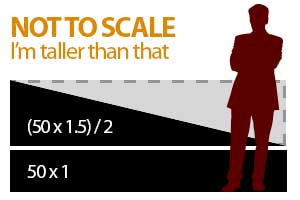According to the esteemed University of North Dakota (and who am I to argue with such academic giants?) the light and fluffy snow that we like to make snow angels in and make home movies of our dogs plowing through can mass around 7 US pounds per cubic foot. More average, denser snow, can come in at 15 pounds per foot, while drifted snow is denser still, since it is compacted (think snowman) and can come in at 20 pounds per cubic foot or more. I’m going to take 17 pounds per cubic foot as my base for this calculation, since it involves both drifted snow and snow which had been compacted by that most fearsome of the mechanized beasts of Winter, a municipal snow plow. We love them.
From the rear of my car to the road on this particular day was only about 50 feet. My driveway is a ballpark average of 10 feet wide. 500 square feet. The sidewalk, which one must clear by law in case some otherwise intelligent passerby slips and sues you, is 40 feet across the front of the house by 3 feet in width, adding another 120 square feet. The car itself had a foot of snow on the roof and packed under the wheels too, but let’s not quibble over details and just go with what we have: 620 square feet of snow to clear.
At the rear of my car, the snow was a foot deep. Now, we’re talking cubic. Car to road is 50 feet by 10 feet by 1 foot, total 500 cubic feet. Sidewalk, 120 square feet. If we say it was a foot deep at all points that’s another 120 cubic feet of snow. Close enough.
 There’s more. At the roadside, the snow was nearer 2.5 feet deep (probably more, I’m rounding down) due to the plow (blessed be those that driveth them).
There’s more. At the roadside, the snow was nearer 2.5 feet deep (probably more, I’m rounding down) due to the plow (blessed be those that driveth them).
The snow sloped evenly between the rear of the car and the road due to drifting, and of course the entire road frontage was one solid block where the plow had passed. This is where that algebra you learned in school kicks in (ha! The joke is on you if you thought you would never need it, kids!) and we calculate the slope. Easy enough. See diagram. 🙂
We take the volume of an imaginary rectangle and divide by two, to get the volume of the slope area separately. (50 x 10 x 1.5) / 2, gives us an extra 375 cubic feet.
Now we add. 375 cubic feet of slope, plus 500 cubic feet on the driveway, and 120 cubic feet on the sidewalk. Ignore the car! That gives a total amount of snow on the sidewalk, and between car and road, of 995 cubic feet of wet white stuff. Are you with me so far?
The last calculation is simple. At a conservatively estimated 17 pounds of snow per soggy wet cubic foot, I shoveled 995 cubic feet of snow. A total of 16,915 US pounds. There are 2,000 pounds in a US ton. The math says that I shoveled over eight tons of water yesterday. That seems impossible, right?
Please, check my math. Tell me if I’m wrong, but I checked it a few times because I didn’t believe it myself. I think you’ll find it accurate. No wonder snow clearance is a leading cause of heart attack and sudden death in Canada. That’s a lot of water to move.
I definitely learned something today. I learned that I will park closer to the road next time.